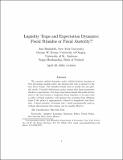Files in this item
Liquidity traps and expectation dynamics : fiscal stimulus or fiscal austerity?
Item metadata
| dc.contributor.author | Benhabib, Jess | |
| dc.contributor.author | Evans, George W | |
| dc.contributor.author | Honkapohja, Seppo | |
| dc.date.accessioned | 2014-10-15T09:31:00Z | |
| dc.date.available | 2014-10-15T09:31:00Z | |
| dc.date.issued | 2014-08 | |
| dc.identifier | 155102990 | |
| dc.identifier | 0bf13b05-accb-4f2e-8f92-2dec18e42feb | |
| dc.identifier | 84904874515 | |
| dc.identifier | 000340694600013 | |
| dc.identifier.citation | Benhabib , J , Evans , G W & Honkapohja , S 2014 , ' Liquidity traps and expectation dynamics : fiscal stimulus or fiscal austerity? ' , Journal of Economic Dynamics and Control , vol. 45 , pp. 220-238 . https://doi.org/10.1016/j.jedc.2014.05.021 | en |
| dc.identifier.issn | 0165-1889 | |
| dc.identifier.uri | https://hdl.handle.net/10023/5541 | |
| dc.description | Financial support from National Science Foundation Grant no. SES-1025011 is gratefully acknowledged. | en |
| dc.description.abstract | We examine global dynamics under infinite-horizon learning in New Keynesian models where the interest-rate rule is subject to the zero lower bound. The intended steady state is locally but not globally stable. Unstable deflationary paths emerge after large pessimistic shocks to expectations. For large expectation shocks that push interest rates to the zero bound, a temporary fiscal stimulus, or in some cases a policy of fiscal austerity, will insulate the economy from deflation traps if the policy is appropriately tailored in magnitude and duration. A fiscal stimulus "switching rule," which automatically kicks in without discretionary fine-tuning, can be equally effective. | |
| dc.format.extent | 19 | |
| dc.format.extent | 376556 | |
| dc.language.iso | eng | |
| dc.relation.ispartof | Journal of Economic Dynamics and Control | en |
| dc.subject | Adaptive learning | en |
| dc.subject | Monetary policy | en |
| dc.subject | Fiscal policy | en |
| dc.subject | Zero interest rate lower bound | en |
| dc.subject | HB Economic Theory | en |
| dc.subject | BDC | en |
| dc.subject | R2C | en |
| dc.subject.lcc | HB | en |
| dc.title | Liquidity traps and expectation dynamics : fiscal stimulus or fiscal austerity? | en |
| dc.type | Journal article | en |
| dc.contributor.institution | University of St Andrews. School of Economics and Finance | en |
| dc.identifier.doi | 10.1016/j.jedc.2014.05.021 | |
| dc.description.status | Peer reviewed | en |
This item appears in the following Collection(s)
Items in the St Andrews Research Repository are protected by copyright, with all rights reserved, unless otherwise indicated.

